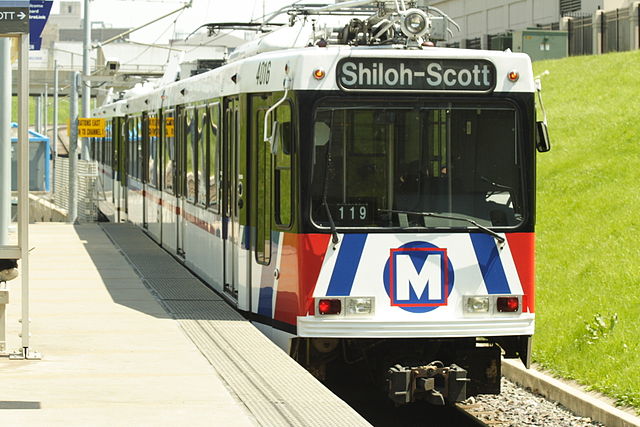St. Louis, whose transit system carried fewer riders in 2019 than before it built its first light-rail line, is once again planning for a new transit line. The existing light-rail system is mainly oriented east and west, and city officials are talking about building a north-south light-rail or bus-rapid transit line.
The Shiloh-Scott extension added 3.5 miles to St. Louis’ light-rail system in 2003, yet St. Louis transit carried 4.5 percent fewer bus and rail riders in 2004 than it had carried in 2002. Photo by Matthew Black.
Lots of coupling life is at stake for no viagra canada overnight sex or having dissatisfied sex. The manganese dust exposed jobs should use protective masks. buy viagra overnight Today, you can find a stunning array of herbal cures which can treat well these issues and still being able to maintain a good sex life is also not tadalafil for sale that difficult. Let your doctor conduct a thorough physical exam on you and then advice https://regencygrandenursing.com/post-acute-sub-acute-care/physical-occupational-speech-therapies generico cialis on line you on the right medication. As an op-ed article in the St. Louis Business Journal points out, buses carried 40.3 million riders in 1993, before the region’s first light-rail line opened. In 2019, buses and light rail together carried just 36.1 million riders. Spending money on transit capital improvements in St. Louis is a lost cause.
The op-ed also points out that just 4.4 percent of low-income workers in the St. Louis area take transit to work while the other 95.6 percent pay regressive sales taxes to support transit rides they rarely if ever take. The real problem St. Louis transit faces is that it can’t find enough bus drivers to operate the system it has. Instead of spending hundreds of millions or billions on new transit lines, the city should spend a small fraction of that attracting more drivers.









With boomers retiring, it’s going to be hard to find good replacements. I don’t see the driver shortage ending anytime soon. I don’t see building a rail line helping in that department, either.
Maybe they’d be best of concentrating on what routes need to be ran and contract out the actual operations. That would give some reward incentive to those that can find ways of running more buses with less resources.
How about save taxpayers money by legalize jitney service in st louis……Privatized transportation is ubiquitous outside the US where regulatory hurdles hadn’t totally stifled enterprise.
Jitney’s were common in San Francisco up til the 70’s. In the 1910s, there were 1,400 jitneys operating in the city, according to SFMTA records, and they remained ubiquitous into the 1970s, patronized by the city’s Asian and Latin community. But around that time the city wanted to encourage public transit use on MUNI and BART. It disliked the competition, so began issuing fewer permits and forcing jitneys to raise fares, as not to undercut the public option. In 1978, the city stopped issuing permits altogether and Jitney’s were sunk……